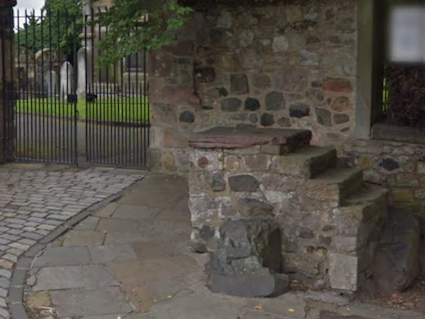It was like one of those mystery shopping contests where someone enters a store and suddenly confetti and balloons rain from the ceiling when the one-millionth customer crosses the threshold, and wins a big prize. Except it was four thousand. And I couldn’t provide anything valuable. Congratulations to “Peter” for posting Twelve Mile Circle’s 4000th comment from an actual human(¹).
I’m glad it was Peter because he’s been a longtime reader and commentator on Twelve Mile Circle. I thought about doing something similar for a different big round number awhile ago and lost interest after it was some random one-time visitor with a particularly bland observation. Peter deserved better treatment, though. I offered to research an article featuring the geo-oddities of a town of his choice.
Medford
Peter kindly suggested two options, Waterbury, Connecticut and Medford, New York. I set aside Waterbury. I could never serve Connecticut-style (Connecticutiana?) weirdness like the fine writing of Steve over at Connecticut Museum Quest. I’d probably want to talk about the Waterbury Button Museum(²) or Holy Land USA, and of course Steve already covered those way beyond my skills.
Thus, 12MC moved on to Medford. I could have talked about a lot of things:
- The oddly oval street with the awesome topiary
- The rare sight of an actual street cleaner in action
- The street named for a cheezy newspaper cartoon character that I didn’t realize still existed but apparently does
- The confounding connection to Virginia, or maybe that’s just because I’m sensitive to all things Virginia (e.g., Mt. Vernon Ave., Richmond Ave., Virginia Dr., Blue Ridge Golf Club). There was a veritable confederacy of Virginia place names in Medford!
- The 12’9″ low clearance bridge (however, do not stare at the billboard. That would be rude)
- The partial alphabetical-order street grid in one section of town where every other street followed the pattern (ACORN, rhode island, BEECHNUT, newport, CHESTNUT, new london, DEVON…)
- The salvage company with its own railroad connection
- Carvel Ice Cream? Cookie Puss®.(³)
Indeed, any of those threads might have been worth pursing. Once again I uncovered supporting evidence of a hypothesis that extended way back to the very earliest days of 12MC, that geo-oddities exist everywhere. I found sufficient material right there for probably a half-dozen articles. I sidestepped all of that. In fact, it led me to an earlier time and another continent.
Horseblock
What in the world was a horseblock other than the name of a major road through Medford? Obviously it bore some significance, perhaps extending back before the village coalesced around a Long Island Railroad station in the mid-19th Century.

A horseblock, put simply, was “a step or block of stone, wood, etc., for getting on or off a horse or in or out of a vehicle.” They were once quite common. Practically every church, hotel, shop or public square catering to polite society would have offered such a horseblock as a matter of modesty or convenience. Imagine a woman in a long, flowing dress attempting to maintain some dignity as she climbed into a carriage, or an elderly gentleman no longer quite as nimble as he once was, wishing to ride horseback. Only barbaric establishments would have lacked a simple horseblock.
Few horseblocks remain outside of equestrian centers except as quaint, nostalgic reminders of centuries past. Wellington’s horse block in London serves as one such example (map and image above). The Duke of Wellington, as described on the plaque attached to the block, “desired” this specific convenience at this spot in 1830 and so it exists in perpetuity. It served members of the United Services Club, a social group of high-ranking military officers that no longer exists. Even today the parking space in front of this horseblock, and its companion horseblock on the other side of the road, must remain clear in case Wellington’s ghost shows up on spectral horseback and he needs to dismount.
Horseblocks Are Largely Forgotten

I found a brief list of horseblocks, as well as a couple of alternate names for them such as mounting blocks, or in Scotland loupin’-on-stanes (stones to be leapt upon?). Speaking of Scotland, notice this wonderful example of a horseblock in front of Duddingston Kirk on Old Church Lane, Duddingston Village, Edinburgh (map). It’s not exactly a stairway to heaven, more like a stairway to nowhere.
Sorry, Peter, I never discovered the specific horseblock that influenced the naming of Horseblock Road in Medford. It might be lost to history or it may be waiting for someone to post it on the Intertubes. It was likely more memorable as a local landmark a hundred or more years ago when people actually needed horseblocks.
The Fine Print Nobody Reads
(¹) But Tom, you say, clearly that’s comment 5743, to which I reply, yes, and now you understand the dimensions of comment spam. Those extra 1743 were the particularly persistent ones that made it through two levels of filters and had to be deleted manually from the moderation queue. The filters probably blocked many hundreds of times that amount.
(²) I would never suggest that anyone go over to CTMQ’s button page and ask Steve to appraise a button. That would simply be mean.
(³) I think the Washington, DC area may have been at Carvel’s far, far, far southern extreme. We’d get those awful homemade advertisements only on the televisions stations that weren’t part of the big-3 networks, the ones that required extra jiggling on the rabbit ears just to catch a staticky signal with reruns of Gilligan’s Island

Leave a Reply